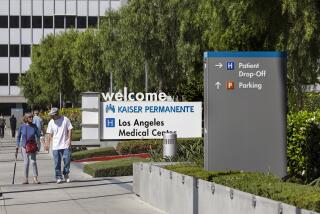Lack of quality ratings on Covered California site is criticized
California’s insurance exchange came under fire for its plan to withhold quality ratings of health plans until late 2015 while thousands of consumers shop for coverage under the federal healthcare law.
The state exchange, Covered California, said Tuesday that it had reliable ratings on only four of the 12 participating health insurers primarily because their networks of doctors and hospitals have changed so much for new policies available next year.
“We don’t think providing partial information is helpful, and it might be more harmful,” said Dr. Jeffrey Rideout, senior medical advisor at Covered California. “History is sometimes a good predictor of future performance, but in this case it’s not.”
Rideout said the earliest that quality ratings would appear on the exchange is October 2015, after the state has time to survey patients and examine claims data.
Another state agency, the Office of the Patient Advocate, already publishes annual ratings of the largest HMO and PPO plans, handing out one to four stars in a variety of categories. The report card looks at whether insurers are meeting national standards for recommended care, and it asks patients to rate their own experience.
Both consumer advocates and HMO giant Kaiser Permanente criticized Covered California’s move and said they would try to persuade the exchange’s five-member board to reconsider at a meeting Thursday. Critics said the delay rewards lower-performing insurers and forces consumers to focus on price alone.
“It’s disappointing because consumers care about this information,” said Betsy Imholz, special projects director for Consumers Union. “Other states are going forward with these ratings. I don’t think we should require it to be perfect.”
Kaiser Permanente and two other insurers — Sharp Health Plan in San Diego and Western Health Advantage in Sacramento — complained in a letter to the exchange this week that “there has never been a compelling reason to deny this information to consumers.... On this issue, Covered California has surrendered its ‘pace car’ status.”
Also Tuesday, state officials announced that 125,929 applications for insurance were started through Oct. 19, covering the first three weeks of enrollment. That reflects a drop-off in applications compared with more than 50,000 that were started during the second week of enrollment. Both Web traffic and call volume decreased slightly compared with the previous week.
Covered California has declined to say how many people have completed an application, and it doesn’t plan to release enrollment figures until next month. Open enrollment in the exchange runs through March 31.
The state also faces a backlog of several thousand enrollment counselors and insurance agents who are waiting to be trained and certified.
But the state did make progress addressing one of its most stubborn computer glitches. The exchange said it partially restored its online directory of medical providers with a search tool for individual physicians in various health plans. It said it’s still working on information related to hospitals, medical groups and other providers.
The online-provider tool had been offline since Oct. 9 while the state fixed errors and made the information easier to search.
“Getting that back online was very important as an enrollment tool for consumers,” Rideout said.
Covered California ignited a debate over the quality ratings in August when it backed off plans to include the information in its online enrollment system. This came as a surprise because state officials had touted the idea of consumers choosing coverage based on the overall value, combining price and quality measures.
But many of the insurers in the exchange, such as Blue Shield of California and Health Net Inc., significantly reduced their provider networks in the exchange to help lower premiums. Insurers said that meant previous state ratings didn’t accurately reflect these new plans.
In contrast, Kaiser is using its full provider network, and its premiums in the exchange are often more expensive than its chief rivals’.
Consumer advocates pointed out that other state-run exchanges, such as those in Colorado, Maryland and Oregon, are displaying quality data prominently on their websites. Colorado’s website even sorts a consumer’s options by quality, rather than just price.
Kaiser routinely scores well in rankings on quality of care and patient satisfaction. It was the only HMO in the state to earn a top four-star rating for providing recommended care on the most recent report card. Sharp and Western Health each received three stars on the same measure.
The narrow networks at the center of this debate over quality ratings were a hot topic at an insurance industry conference Tuesday in Huntington Beach.
Paul Markovich, chief executive of Blue Shield, said these narrower networks are an appropriate trade-off for keeping premiums in check.
“We have to get real because we are facing an affordability crisis,” Markovich said. “You can’t sell a Lamborghini to someone making minimum wage. These choices are here to stay.”
Twitter: @chadterhune







